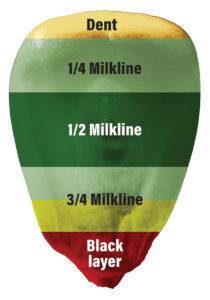Harvest Corn Silage at Optimal Milkline to Add to Your Bottom Line
Corn silage season is approaching quickly, so it’s a good time to review basics like how to determine when to harvest.
As the kernel matures from the dented cap, the milkline moves toward the kernel tip where it attaches to the cob. Harvesting at 50% milkline generally achieves approximately 65% whole-plant moisture. Optimal harvest for bunks/bags is 65 to 70% whole-plant moisture, or one-half to one-fourth milkline. Optimal harvest for stave upright silos is 63 to 65% whole-plant moisture, or three-fourths to one-half milkline.
Think of the kernel as a sponge. As the milkline develops, the kernel absorbs more moisture from the chopped residue. If you harvest silage corn that is too wet, juicing can occur. Inadequate fermentation and mold development also may result. It is advantageous to do a formal moisture check using a koster crop tester, for example.
One of the biggest drivers for milkline development is weather. Moisture, fertility, heat and plant health are four big drivers affecting milk line movement. When the plant is at full photosynthetic capacity, the corn silage whole-plant moisture can decline daily from 0.5 to one percent. Photosynthetic activity slows when the weather is cold, wet or cloudy, causing the corn plant to mature slower. Look at the forecast as harvest approaches because many changes can occur in five days.
Another way to improve the quality of corn silage is by raising the chopping height as most lignin accumulates in the lower portion of the stalk. Lignin is the structural component that helps plants stand. It’s a tradeoff to find the correct cutting height to maximize forage quality and to capture the most tonnage.
Some forage producers increase cutting height to help reduce moisture, so they can get started earlier. Raising the chop height 12 inches in a Penn State study left about 0.6 ton in the field but forage quality improved. Improved quality produces more milk for dairy farmers!
If you have any questions feel free to reach out at coreyc@lathamseeds.com.
